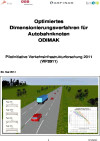OdimAk – Optimized dimensioning procedure for highway interweavings
Short Description
Starting point / motivation
For the operational analysis of intersections at motorways and highways, weaving segments are very important with respect to capacity and safety. At weaving segments two or more unidirectional movements of vehicles merge and divert.
In Austria, RVS 03.05.13 is applied to compute capacity at weaving sections. However, the current method is limited to single (2-lane) weaving segments; e.g. vehicles of two parallel movements can switch between lanes.
However studies indicated that the RVS method was not state-of-the-art anymore (BRILON et al. 1993, HOFFMANN et al. 2000, HBS 2005, CINDIRC et al. 2007 und BETZ 2008). Additionally there was no method currently available in Austria to represent the case of multiple weaving segments with three or more weaving movements, which can be found frequently within the road network of the ASFINAG.
A comprehensive revision of RVS 03.05.13 requires an adaptation of the current method for the single weaving segments (2 lanes) as well as a new method for multiple weaving segments (3 and more lanes).
Contents and goals
For the determination of the performance and traffic safety of junction to the motorways and expressways, the weaving sections, moreover the areas with the required lane change and the passage of several traffic streams in the same direction are of particular importance. There is currently no valid design specification for the in Austria the increasingly frequent case of the implementation of three traffic flows with the resultant multiple lane change for vehicles.
Due to the requirements of the tender, ODIMAK will only focus at multiple weaving segments although the developed general method should also be applicable for single weaving segments.
Methods
Measured data was combined with modeled data. Simulation models have the advantage of a closed laboratory environment suitable to test different parameter impacts on traffic flow one after the other. At the moment of implementation different simulation tools were calibrated within the research project of the German BAST "HBS-fitted simulation of traffic flow on motorways" undertaking new measurements.
Especially weaving sections are looked at, since they were difficult to model realistically. ODIMAK applied a similar methodology taking additional measurements in Austria. The study includes variations on traffic volumes, traffic volume ratios between weaving movements, weaving speed and weaving length.
Furthermore the methodology and the results were discussed in workshops with experts from ASFINAG, BMVIT and the FSV committee on interveaving as a base for revising the relevant RVS.
Results and Conclusions
The results of the simulations were presented in the form of well readable nomograms, which were also presented to the FSV Work Committee for the revision of RVS 03.05.13.
With the investigations carried out, the capacity can be determined for interweaving s with multi-lane inlets or exits (interweaving type V3, V3 +, V4 and V4 +). For the standard case (interweaving type V1, VR1 and V2) a revision is recommended according to the methodology presented in ODIMAK.
Publications
OdimAk – Optimized dimensioning procedure for highway interweavings

The project ODIMAK dealt with a new capacity analysis method for multi-level intersections based on existing guidelines. Measurements of complex weaving procedures on the ASFINAG network were taken into account. A microscopic traffic simulation tool was applied to develop an analysis method for multiple weaving segments. The traffic flow model was calibrated using the previous measurements. Typical geometrical settings were defined and modeled. The simulation results are taken for regression analysis to identify suitable dimensioning procedures, which were discussed within the FSV committee on intersections.
DI Michael Cik, Prof. Dr.-Ing. Martin Fellendorf, DI Roland Fenzl, DI Erich Gaube, DI Dr. techn. Georg Kriebernegg
Publisher: BMVIT
German, 100 Seiten
Publication Downloads
Project Partners
Project manager
Dr. Georg Kriebernegg, IKK Kriebernegg-Kaufmann ZT-GmbH
Project partner
Univ. Prof. Dr. Martin Fellendorf, TU Graz - Institute of Traffic Sciences
Contact Address
IKK Kriebernegg-Kaufmann ZT-GmbH
Dr. Georg Kriebernegg
Tel.: +43 (316) 391110-12
E-mail: g.kriebernegg@ikk.at
